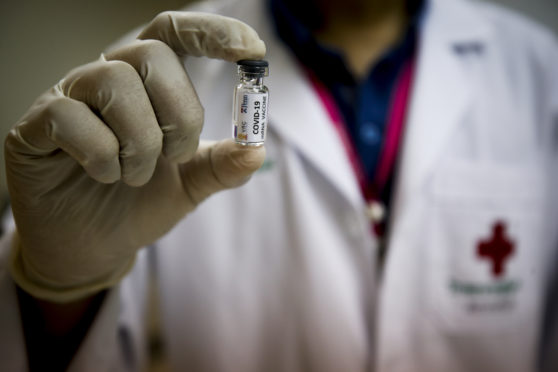
A coronavirus vaccine candidate developed by the University of Cambridge could begin clinical trials in the UK in the autumn.
A £1.9 million funding boost from Innovate UK, the Government’s innovation agency, has provided support for a collaboration between Cambridge spin-out company DIOSynVax, the University of Cambridge and the University Hospital Southampton NHS Foundation Trust.
SARS-CoV-2 – the virus that causes Covid-19 – is a coronavirus.
Coronaviruses are named after their appearance – spherical objects, with spike proteins sitting on the surface.
The virus uses these spikes to attach to and invade cells in the body.
One vaccine strategy is to block this attachment, but not all immune responses against the virus and spike protein are protective.
Antibodies to the wrong part of the spike protein have been implicated in triggering hyper-inflammatory immune responses causing life-threatening Covid-19 disease, experts say.
Additionally, Covid-19 is mutating and changes in the spike protein during the pandemic have already been observed.
The research team used banks of genetic sequences of all known coronaviruses, including those from bats, the natural hosts of many relatives of human coronaviruses, to develop their vaccine candidate called DIOS-CoVax2.
They have developed libraries of computer-generated antigen structures that can train the immune system to target key regions of the virus and system to make good anti-viral responses.
These immune responses include neutralising antibodies, which block virus infection, and T-cells, which remove virus-infected cells.
Researchers say this “laser-specific” computer-generated approach is able to help avoid the adverse hyper-inflammatory responses that can be triggered by recognition of the wrong parts on the virus’s surface.
Professor Jonathan Heeney, head of the Laboratory of Viral Zoonotics at the University of Cambridge, and founder of DIOSynVax, said: “Our approach involves 3D computer modelling of the SARS-CoV-2 virus’s structure.
“It uses information on the virus itself as well as its relatives – SARS, MERS and other coronaviruses carried by animals that threaten to ‘spill over’ to humans again to cause future human epidemics.
“We’re looking for chinks in its armour, crucial pieces of the virus that we can use to construct the vaccine to direct the immune response in the right direction.
“Ultimately we aim to make a vaccine that will not only protect from SARS-CoV-2, but also other related coronaviruses that may spill over from animals to humans.
“Our strategy includes targeting those domains of the virus’s structure that are absolutely critical for docking with a cell, while avoiding the parts that could make things worse.
“What we end up with is a mimic, a synthetic part of the virus minus those non-essential elements that could trigger a bad immune response.”
While most vaccines use RNA or adenoviruses to deliver their antigens, DIOSynVax’s is based around DNA.
Once an antigen – a toxin or other foreign substance which induces an immune response in the body – is identified, the key piece of genetic code that the virus uses to produce the essential parts of its structure is inserted into a DNA parcel known as a vector.
The body’s immune cells take up the vector, decode the DIOS-vaccine antigen and use the information to programme the rest of the immune system to produce antibodies against it, researchers say.
The Innovate UK funding will allow the team to take the vaccine candidate to clinical trial.
This will take place at the National Institute for Health Research (NIHR) Southampton Clinical Research Facility at the University Hospital Southampton NHS Foundation Trust and could begin as early as autumn this year.

Enjoy the convenience of having The Sunday Post delivered as a digital ePaper straight to your smartphone, tablet or computer.
Subscribe for only £5.49 a month and enjoy all the benefits of the printed paper as a digital replica.
Subscribe